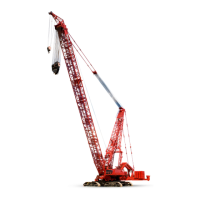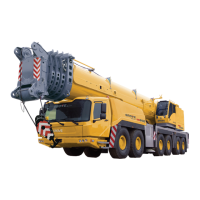SET-UP AND INSTALLATION 777 OPERATOR’S MANUAL
4-68 Published 10-01-12, Control # 044-05
Breaking in Wire Rope
After installing a new wire rope, break it in by operating it
several times under light load and at reduced speed. This
practice allows the wire rope to form its natural lay and the
strands to seat properly.
NOTE: Wire rope will stretch during the break-in period,
reducing the wire rope’s diameter as the strands
compact around the core.
The dead wraps of wire rope on the drum can become slack
during operation, even if the utmost care is used during
installation of the wire rope. This slackening is caused by the
normal stretch that occurs in a new wire rope under tension
and periodically throughout the wire rope’s life from release
of the load.
When slackness is noted, tightly wind the dead wraps of wire
rope onto the drum. If left uncorrected, a wedging action with
subsequent layers will occur, and the resultant abrasion may
cause broken wires in the dead wraps.
PAD EYE USAGE FOR WIRE ROPE
REEVING
See Figure 4-45 for following procedure.
General
Some rotation-resistant wire rope supplied by Manitowoc is
equipped with a No. 1.5 pad eye welded to the leading end of
the wire rope.
A sucker-line can be attached to the pad eye to make it
easier to reeve the load block.
Safety
1. For No. 1.5 pad eye, do not exceed 1,000 lb (4.45 kN)
single line pull.
2. Make sure sucker line and rope clips are rated for at
least 1,000 lb (4.45 kN) line pull.
3. Inspect pad eye prior to each use. Replace it if:
• Any original dimensions have changed
(Figure 4-45).
• Cracks or breaks exist in metal or weld.
WARNING
Flying Part Hazard!
Pad eye on end of wire rope has been provided for
reeving purposes only. Any other use is neither
intended nor approved.
Pad eye can break and fly apart with considerable force if
it is overloaded, not used properly, or not maintained
properly.

